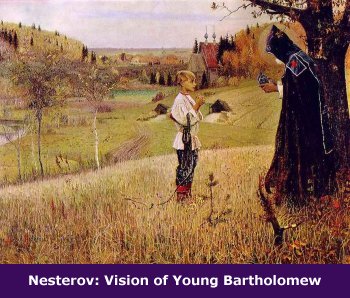

 Even though the career of Mikhail Vasilievich Nesterov bridges the 19th and the 20th centuries, he is best known as a nineteenth-century painter of lyrical religious scenes and one of the fathers of the artistic movement known as
World of Art. He was born in 1862 in Ufa, in a merchant family with artistic interests. From 1877 to 1881 he studied at the Moscow School of Painting, Sculpture and Architecture under the guidance of Vasily Perov, Alexei Savrasov, and Illarion Pryanishnikov. He left the Moscow Art School in 1881 and worked with Pavel Chistyakov at the Academy of Arts at St. Petersburg until 1884. In 1884, he went back to Moscow. There, he met a group of influential painters at the estate of Savva Mamontov at Abramtsevo. Being a deeply religious man he sought to combine his Orthodox beliefs with the Art Nouveau style of the time. In his attempt to revive religious art, he was influenced more by French Symbolism than by old Russian icon painting.
Even though the career of Mikhail Vasilievich Nesterov bridges the 19th and the 20th centuries, he is best known as a nineteenth-century painter of lyrical religious scenes and one of the fathers of the artistic movement known as
World of Art. He was born in 1862 in Ufa, in a merchant family with artistic interests. From 1877 to 1881 he studied at the Moscow School of Painting, Sculpture and Architecture under the guidance of Vasily Perov, Alexei Savrasov, and Illarion Pryanishnikov. He left the Moscow Art School in 1881 and worked with Pavel Chistyakov at the Academy of Arts at St. Petersburg until 1884. In 1884, he went back to Moscow. There, he met a group of influential painters at the estate of Savva Mamontov at Abramtsevo. Being a deeply religious man he sought to combine his Orthodox beliefs with the Art Nouveau style of the time. In his attempt to revive religious art, he was influenced more by French Symbolism than by old Russian icon painting.
Nesterov often traveled to the most remote parts of Russia to live and study in monasteries and hermitages. This gave him the background and information necessary to accurately depict the conditions that the saints and hermits lived in. Compositionally, Nesterov's paintings were not very complex, consisting of the simplest elements, and they always depended on a lyrical synthesis between the figures and the surrounding landscape. The figures were arranged either singly or in a row in the foreground. In the background, behind the figures Nesterov placed delicate and poetic Russian landscape -- birch trees, forests and groves, quaint wooden churches, fields and meadows. This allowed him to create a special aura of mysticism and spirituality, an artistic interpretation of Russian piety and medieval faith.
Throughout his life Nesterov excelled in painting frescoes and icons for renovated churches and creating oil paintings devoted to medieval Russia. When the new church of St. Vladimir in Kiev was built in 1882, the artist was given the task of decorating it with various wall paintings, which he successfully accomplished. Additionally, Nesterov's originals served as models for the external mosaics and icons in the iconostasis in St. Petersburg's Cathedral of the Savior on the Blood. The first painting to gain the critics' attention was the Bride of Christ (1887), a study of a young novice in a nunnery. The painting, full of lyrical sadness, was Nesterov's response to the death of his wife. Between 1888-1889 he painted the Hermit, which portrays an old pilgrim against a northern landscape of trees and the still waters of a lake. After the Hermit, Nesterov, who lived close to the St. Trinity Monastery, turned to the subject of St. Sergius of Radonezh. The first (and the most famous) painting devoted to the topic was Vision of Young Bartholomew (1890). St. Sergius' Youth (1892-97), The Deeds of St. Sergius (1896-7), and St. Sergius of Radonezh (1891-99) followed. Around 1900, Nesterov created The Holy Russia, remarkable for its portrayal of pilgrims and wanderers searching for physical and spiritual healing.
In last years of the 19th century, the realist preoccupation with social problems caused an artistic reaction. It became evident that realistic painting could not act as a social force to alleviate injustice. Another major flaw of this style was that it very rarely led to the creation of true works of art. Nesterov, who had an exquisite taste, came to the conclusion that formal elements were as artistically important as the ends they served. This attitude allowed the painter to become one of the primary artists responsible for launching the artistic movement Mir Iskusstva ('World of Art').
At the beginning of the twentieth century, Nesterov started painting portraits, for instance The Portrait of the Artist's Daughter (1906) and Portrait of Leo Tolstoy (1907). After the October Revolution, he had to abandon his religious painting altogether and instead concentrated on portraiture. Among his sitters were the painters Alexander and Pavel Korin (1930) and the physiologist Ivan Pavlov (1935). Two years before his death he painted the sculptor Vera Mukhina (1940). In 1941, Nesterov received a State Prize and in 1942, shortly before his death, the Order of the Red Banner of Labor. [D.C.and A.B.]
[Sources: Hamilton, Klimov, Lebedev.]
